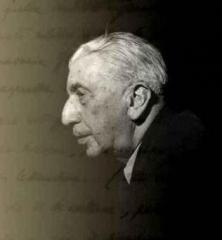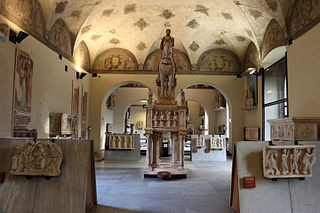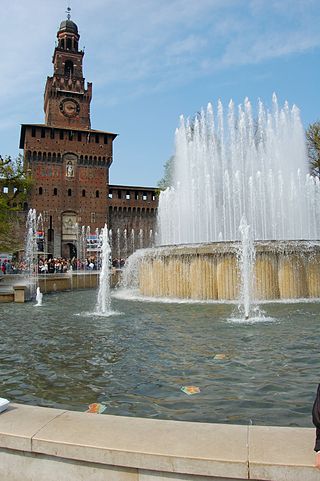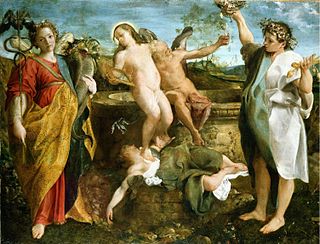
Pietro Longhi was a Venetian painter of contemporary genre scenes of life.

Giovanni Ambrogio Figino was an Italian Renaissance painter from Milan.

The Castello Sforzesco is a medieval fortification located in Milan, northern Italy. It was built in the 15th century by Francesco Sforza, Duke of Milan, on the remnants of a 14th-century fortification. Later renovated and enlarged, in the 16th and 17th centuries it was one of the largest citadels in Europe. Extensively rebuilt by Luca Beltrami in 1891–1905, it now houses several of the city's museums and art collections.

Roberto Longhi was an Italian academic, art historian, and curator. The main subjects of his studies were the painters Caravaggio and Piero della Francesca.

The Trivulzio Madonna is a painting by the Italian Renaissance painter Andrea Mantegna, executed in 1497. It is housed in the Sforza Castle Pinacoteca of the Castello Sforzesco, Milan.

The Italian city of Milan is one of the most-visited tourist destinations in the European Union, with 8.81 million visitors in 2017, putting it 15th in the world when ranked by tourist visits. One source has 56% of international visitors to Milan are from Europe, 44% of the city's tourists are Italian, and 56% are from abroad. The most important European Union markets are the United Kingdom (16%), Germany (9%) and France (6%).

The Museo d'Arte Antica is an art museum in the Castello Sforzesco in Milan, in Lombardy in northern Italy. It has a large collection of sculpture from late antiquity and the medieval and Renaissance periods. The various frescoed rooms of the museum house an armoury, a tapestry room, some funerary monuments, Michelangelo's Rondanini Pietà and two medieval portals.

The Pinacoteca del Castello Sforzesco is an art gallery in the museum complex of the Castello Sforzesco in Milan, northern Italy.

The Applied Arts Collection of Milan is located in the Sforza Castle museum complex under the management of the municipality of Milan, Italy. The museum is divided into several sections with particular emphasis on jewelry, ivories, pottery and art glass.

Daniele Ranzoni was an Italian painter of second half of the 19th century.

Adoration of the Shepherds is an oil on canvas painting dating to 1608, painted by Peter Paul Rubens. It is now in the Pinacoteca civica in Fermo, Italy. It was rediscovered at the start of the twentieth century by the art historian Roberto Longhi, who identified it with the painting recorded as La notte in 1607.

The Sala delle Asse, is the location of a painting in tempera on plaster by Leonardo da Vinci, dating from about 1498. The decoration is of a room in the Castello Sforzesco in Milan. Its walls and vaulted ceiling are decorated with "intertwining plants with fruits and monochromes of roots and rocks" and a canopy created by sixteen trees.

The Bolognini Madonna is a 16th century oil on panel painting by Antonio da Correggio.

Christ Bearing the Soul of the Virgin is a tempera on panel painting measuring 27.5 by 17.5 cm by Andrea Mantegna. It was completed around 1462 and is now in the Pinacoteca Nazionale in Ferrara. It shows Christ in an almond-shaped cloud bearing the soul of the Virgin Mary straight to heaven after her death, accompanied by cherubs - the soul is represented by a statuette, rather than the more usual symbol of a child.

Madonna and Child is a c. 1460–1465 tempera on panel painting by Giovanni Bellini, signed on the trompe-l'œil parapet. It dates from his early phase, when he was still strongly influenced by his father Jacopo and by Andrea Mantegna. The Christ Child holds a fruit, symbolising Original Sin and foreshadowing his Passion. Some art historians feel the haloes and drapery are too archaic for the work to be by Bellini, but the signature's authenticity was confirmed by a 1999 restoration.

Portrait of a Young Man with a Book is an oil-on-panel painting by the Italian Renaissance artist Lorenzo Lotto, now in the Pinacoteca del Castello Sforzesco in Milan, to which it was bequeathed in 1876. At that time its artist was unknown. It is dated to between the end of Lotto's time in Bergamo and his early years in Venice, that is between 1524 and 1527, and more specifically to around 1526.

Lamentation over the Dead Christ is an oil painting on canvas of c. 1515–1520 by Bramantino, painted for the church of San Barnaba in Milan. The work was acquired by the Werner family in 1985 and now in the Pinacoteca del Castello Sforzesco in the same city. A copy is now in a private collection.

Noli me tangere is a fragment of a fresco of c. 1498–1500 by Bramantino depicting Jesus and Mary Magdalene soon after the resurrection. It was originally in the church of Santa Maria del Giardino in Milan and since 1867 in the Pinacoteca del Castello Sforzesco in the same city, to which it was given by Prospero Moisè Loria.

An Allegory of Truth and Time is a 1584–85 oil on canvas painting by Annibale Carracci, now on display in Hampton Court as part of the Royal Collection.

Portrait of Procurator Jacopo Soranzo is a 1550 oil on canvas by Tintoretto, now in the Gallerie dell'Accademia. A larger portrait of the Soranzo with his family also survives, now divided into three parts, all the Pinacoteca del Castello Sforzesco in Milan.




















